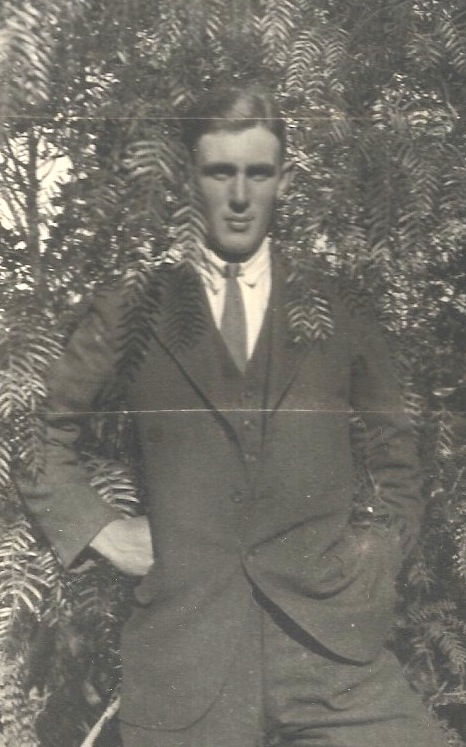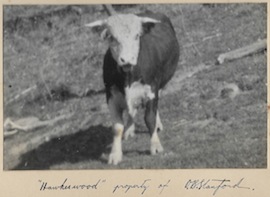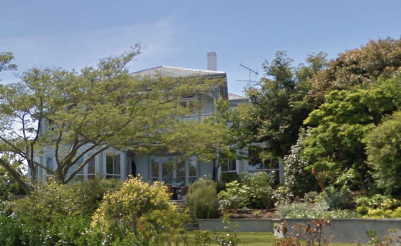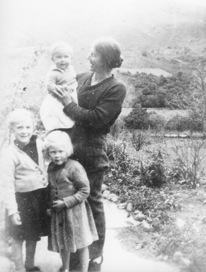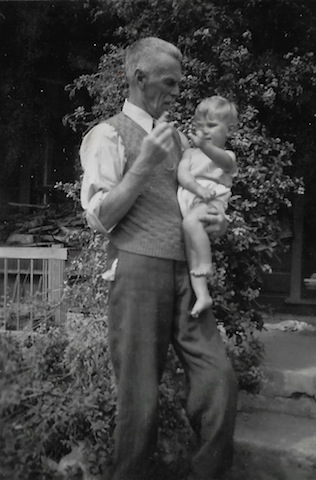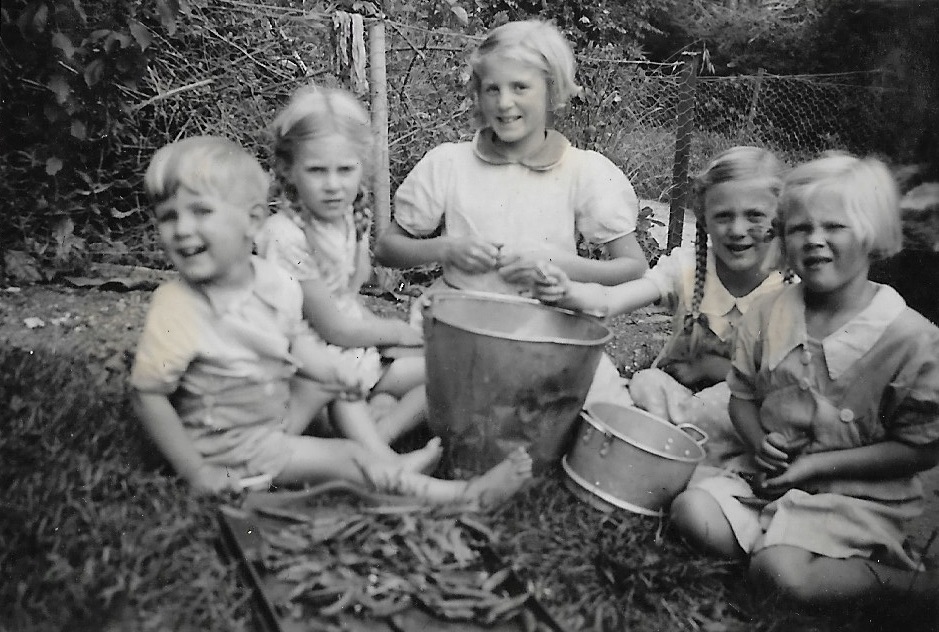Owen was born in 1898 in Amberly.
His parents ran a sheep farm, named Wai-iti in Waikari, north of
Amberly.
Owen wrote "I well remember" (OSM)
that deals with his youth memories and has notes about his
farming life.
Owen of course followed his parents in their frequent moves (see
lives of Edwin Stanford and Charlotte Menzies).
About his years at Wai-iti he writes that the summers
were full of hot NW winds, blowing very hard.
These winds could be so strong,
that on bad days the train from Amberly could not manage
the slope up the valley into the wind and
that the passengers were asked to get out (make the train less heavy)
and help push.
To open the gates on the path from the farm to the road
father Edwin had to wait for the gusts to calm down.
Winters could be very cold, again with winds from the mountain ranges.
In 1903 Wai-iti was sold and they moved to Christchurch.
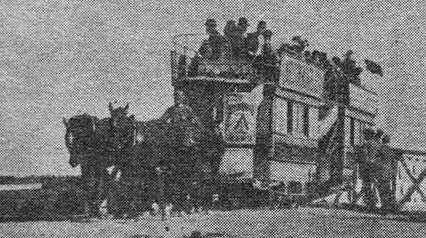
|
The family had rented a "flea invested" (OSM) house
on Pages Road in Aranui close to New Brighton.
Here Owen had his first chance to play with other boys daily.
They had adventures, e.g., with their "daisy car" on the rails
of the tram that ran through Pages Road to New Brighton,
or putting stones on the rails to collect the coloured
powder for "paint", and many other games with the boys.
Sometimes he got severely punished for "mischief",
but on other times father Edwin, with tongue in cheek,
indicated it had been sort of OK.
But soon Owen's father found a farm out west.
In 1903 they moved to "Erinwood", Seafield (east of Ashburton).
There the house was considerably improved and extended by his father.
Owen remembered that his father had the tank for rainwater built
a bit higher than normal, so that his mother could have a
"tap" right next to the back door.
His mother Charlotte was very strict.
She taught Owen to read and mistakes were "corrected" by
slaps in the face.
Under his breath he called her "cross-patch".
But he acknowledges that later in school he could read as one of the best.
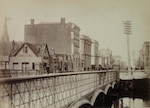
|
Owen recalls that his parents went once every two months to Christchurch (OSM Ch.5). They then stayed at a hotel occupying a suite, or at a Mrs Eastcote, first at the short end of Hereford Street (photo from 1885), later at Fitzgerald Avenue. He remembers seeing, from the tearoom "Broadstreet" on the central square, how masons were busy repairing the cathedral spire after the damage due to the 1901 Cheviot earthquake. The highest part was now being built with wood sheathed with copper, thought to be more stable. His description of Christchurch in those years and the ways of life then is very vivid.
In 1908 Owen lived at Glen-Weem, a farm on the sunny side of a steep slope near Little Akaloa on Banks Peninsula.

|
1913 saw again a move to Christchurch (OSM Ch.7). That move also fitted with Owen going to the prep-school "Dunhelm", together with cousin John Menzies (who had lived with Owen already on the farm, John was son of uncle William Menzies). With school in town, the boys could no longer go bare-foot but had to wear (and clean and polish) boots, as well as shirts with Eaton collar. Owen and John mostly went to school on bicycle. Later they went to Christ's college.
There is a charming story about Owen's health and the opinions of the family doctors (OSM Ch 7). The doctor assured my parents "I had outgrown my strength" (I was 6 ft at age 14) and had a weak heart, I was never allowed to play [wild] games. ..... As a boy of 4 or 5, another doctor had forbidden me raw fruit. As a concession when we were at Menzies Bay, I was allowed 5 ripe gooseberries per day. Thoroughly tested for ripeness, picked by my mother, they were presented to me in a rhubarb leaf. Just before leaving college the "weak heart" doctor was called when I had the flu. We were living at the top of Cashmere Hills. He mentioned my heart and the possible strain of pushing my bicycle up Dyers Pass Road. He nearly had a heart attack himself when I explained I never pushed the bike but rode it up Dyers Pass Road non-stop, from bottom to top. It was not many years after this that I passed the very exacting medical examination for entry as a pilot cadet in the R.F.C. Truly, I think like the woman in the Gospel, I "suffered many things of many physicians". [The "top" was then near Cashmere school; the family lived at Whisby street.]
When Owen was 15, his parents bought a farm near Oaro
between Cheviot and Kaikōura.
Owen suggested to name it "Puke Puke" (little hills)
and no one having a better suggestion, this was agreed to (OSM).
Owen now left school.
The farm needed a lot of "vamping up",
shifting manure, making paddocks and gardens, tree planting.
In 1918, Owen finds time to apply for a training as a pilot;
he passed the exam (see The Press of
19180617).
|
|
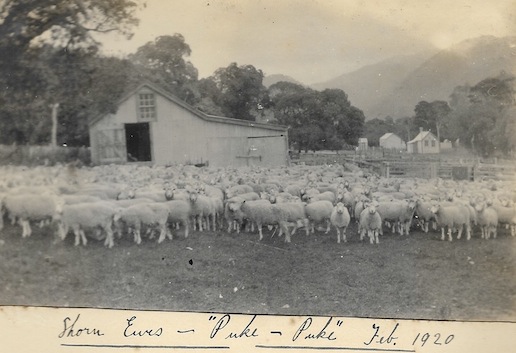
|
There are two photo books (in pAJnS) from the
early days on Puke Puke.
One starts in 1917 and the photos deal mostly with the farm itself
(e.g., Heifers Puke Puke), some of the surroundings
(snow, beach road, Blenheim).
The explaining handwriting is upright.
The second (larger) photobook is with slanted writing
and has photos of Owen and other young people.
The inside cover says "O.B.Stanford"
so it is Owens own photobook,
the former being that of father Edwin.
Owens book starts in 1920 with a photo of a young woman,
"F. Farmer", on a horse.
Then follow sheep at Puke Puke in 1920, "O.B.Stanfords Calves 1920",
O.B.Stanford Napier 1920, some of Christchurch,
a photo of the interior of Puke Puke,
of a bull: "Hawkeswood property of O.B.Stanford",
all of 1920 and 1921.
Then in 1924 three photos with "F.Farmer or F. F.".
Was this a woman to Owens liking?
Owen had embarked in 1922 with his niece Elsie Menzies
on a voyage of almost a year (March to December) to England
and the European continent.
This trip explains the date gap in the photobook.
But there is, after 1924, no follow up with F. Farmer....
Before that, in 1921, he published two "Letters to the
Editor" of the newspaper "The Press".
The second deals with a physics problem related with
water and flotsam in the Waimakariri, getting extensive reactions
(see the clippings).
In 1922, father Edwin had transferred ownership of some of the sheep
to Owen:
215 out of 1030.
Work on Puke Puke continues.
Here follow tidbits from newspaper items
(for details see the
clippings).
1925: he sells sheep at the Kaikōura Fair.
1926: Owen does his first sale of sheep on the Addington market.
New Year in 1926 and 1927 he hosts in Puke Puke some 18 children from the
St. Faith's church in New Brighton
(uncle Clifford Stanford is choirmaster there).
In 1929 Owen helps supervising a camp in New Brighton.
In 1926 he also writes to the newspaper about stray cattle on the
roads. Council says to pay attention.
With his father, Owen invested a great deal of time in making the farm nice,
planting trees (mostly natives, many grown from seedlings),
hedges, making gardens and so on.
His father expanded on the technical improvements
(as he had done on earlier farms),
like a hydro dam, hot and cold streaming water, electricity.
In 1932, Owen started rearing ponies.
The photo (at left; ~1937) shows Owen bringing in the hay.
On the hay is Peter Stanford, in his teens,
the boy adopted by Owens parents.
Peter left later for a farm in Karamea.

|
This farm, Puke Puke (little hills),
became so much the one of Owen, that it was left to him to run.
In 1935, Owens parents moved away to a farm near Cheviot.
Owen became a proficient sheep farmer, he experimented with many
varieties and sought to maximize profit with the best possible wool.
He also had ponies: Shetland Tymore cross.
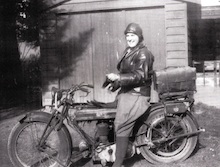
|
Margret Foster-Barham went to an anthroposophical school in England. Then the Foster-Barhams moved to Nelson, and Margaret went to Nelson Girls College. She played basketball in the college team. When she had become an adult, she was allowed to ride her fathers motorbike, a quite unusual thing for a woman at that time.
|
|
Most of the information on Margaret has been adapted from HSM.
Her uncle Alfred Cameron, who was very fond of Margaret, had suggested
that she train as a Home Science teacher at Otago
[college of education in Dunedin].
After graduation in 1931 (Uncle Alfred had died a year earlier)
she indeed went there.
For that, she rode all the way down [almost 800 km]
on the motor-bike over the winding shingle roads,
including the first stretch by the Whangamoa and Rai Valley
[now State Highway 6 from Nelson via the NE to Blenheim].
After her university eduation,
Margaret taught home science in Dunedin and
as of June 1935 at the Diocesan school Craighead in Timaru.
At the next Christmas time she was in Australia (info from her diary).
In 1937, she was with a friend (who had her little daughter along)
on a trip back from Dunedin to Nelson.
The motor broke down and they stopped for a meal;
the girl ordered a "lion" chop.
A man started talking to them, inviting them to call in at Puke Puke
to ride his pony.....
Later, Owen went to Synod in Nelson to look for Margaret there,
but had difficulty tracing her because he thought her name
was "Foster Brown".
But they did meet up.
Owen also visited her at Craighead where she was teaching,
taking a hive of bees for the children to see.
Then (from Margarets diary):
on a ride from Nelson to Craighead she stopped at Puke Puke,
stayed 2 nights, and Owen declared his love.
Then the two went on a trip to Christchurch and
|
On the 3rd of February, 1938, Owen and Margaret married
in the cathedral in Nelson.
One of the flower girls was her niece Helen Aroha Foster Barham.
During the service,
the "Sacred Song" was performed by her sister
Williamina (text at left)
The wedding reception was at her parents home, which has a wide view over
Tasman Bay.
June 1938, Bishop Hilliard and Sister Meredith from Nelson visit
Kaikōura. They are also hosted by Owen.
In that year, Owen donates money to help procure Maori objects
for the Christchurch museum.
He later donates objects.
Children: in Christchurch 12-04-1939 Aprilla Margaret Harriet, 15-02-1941 Prudence Muriel; at Cheviot 07-10-1942 the twins Isobel Anne and Helen Charlotte; in Kaikōura 04-11-1946 Michael Edwin Bedell, 23-08-1948 Judith Allison, 05-09-1958 David Kenneth.
